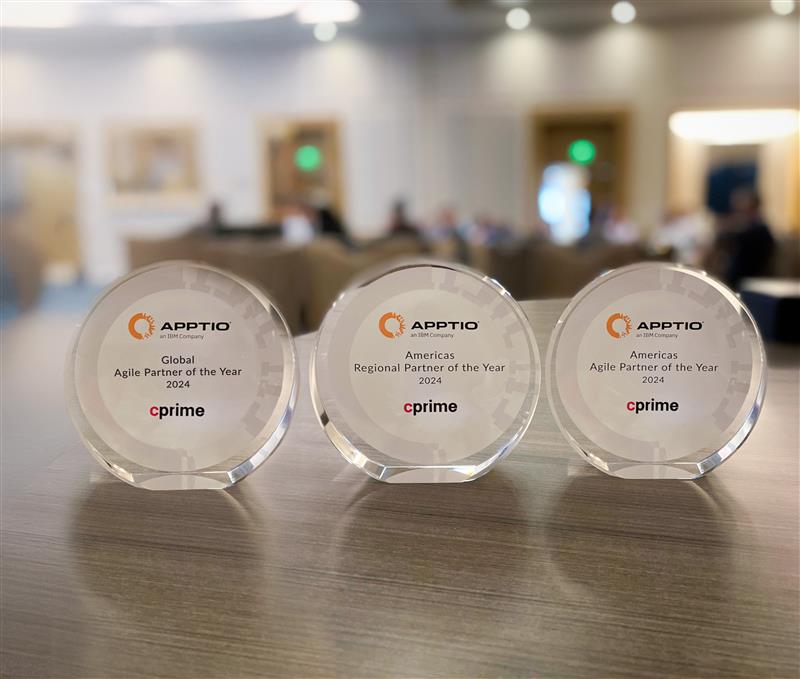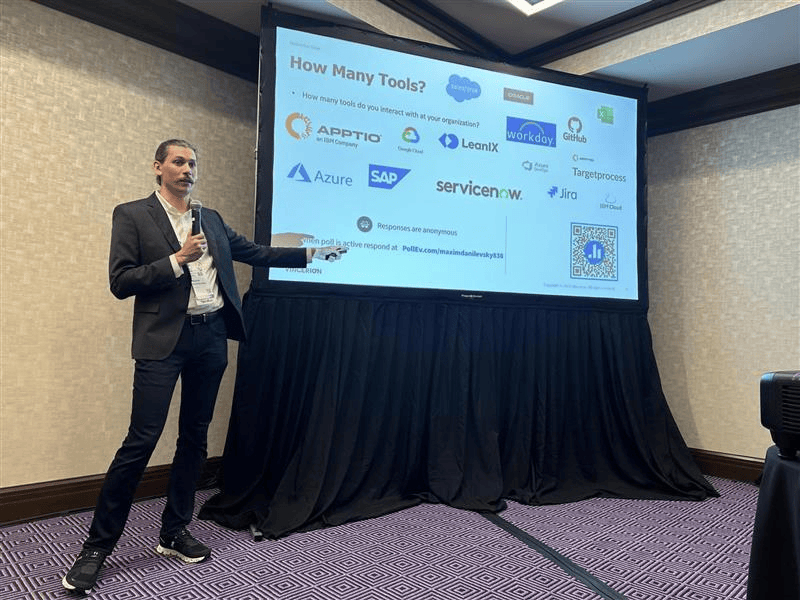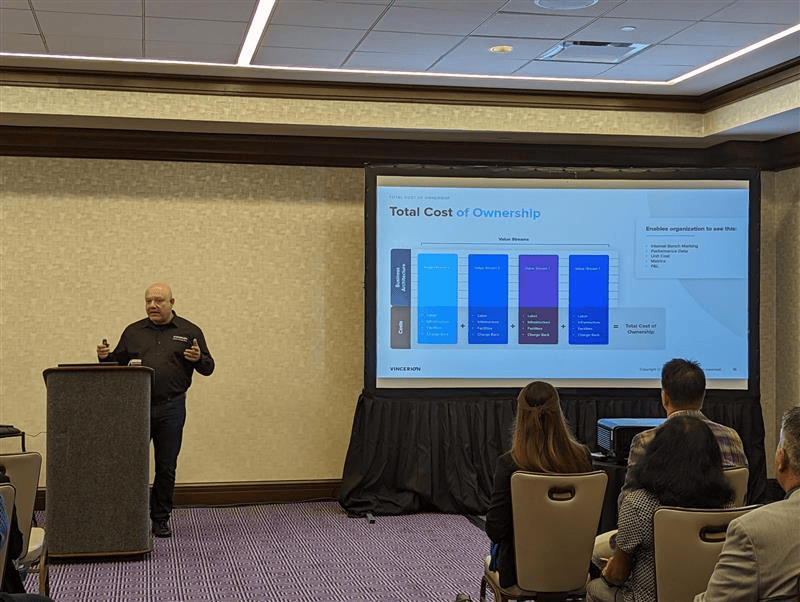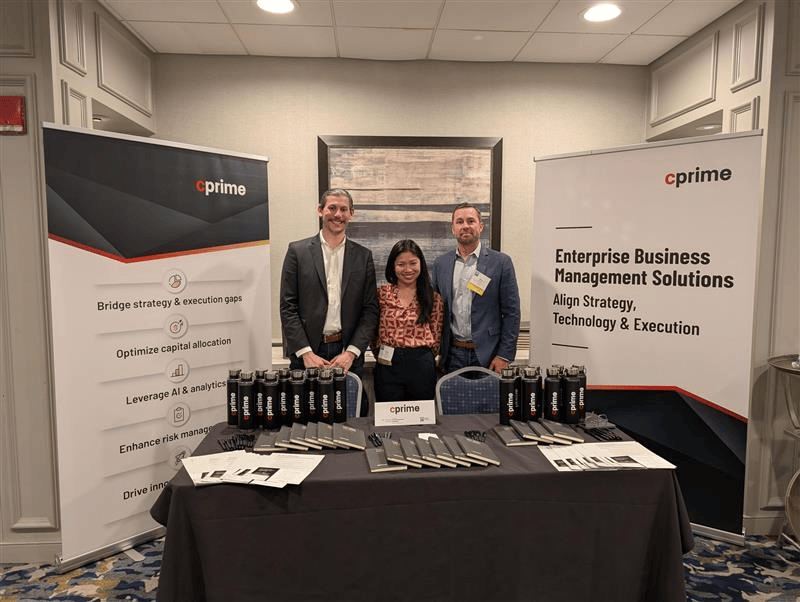Operational excellence FAQs addressed in this article:
-
What is operational excellence in the modern business landscape? – Operational excellence in the modern business landscape is a holistic strategy that aligns technological innovation with a company’s core purpose, culture, and human capital.
-
What are the five pillars of modern operational excellence? – The five pillars of modern operational excellence are strategic clarity and purpose, cultural alignment and defined behaviors, effective management systems, optimized technical systems, and human-centric technology use.
-
How does technology enhance operational excellence? – Technology enhances operational excellence by automating mundane tasks, providing insightful data for decision-making, and enabling employees to focus on higher-value activities, thus acting as a force multiplier.
-
Why is the human factor key to unlocking productivity in operational excellence? – The human factor is key to unlocking productivity because aligning technology with human needs and capabilities ensures that technological investments enhance the skills, creativity, and productivity of the workforce.
-
What is the Operational Excellence Index (OEI)? – The Operational Excellence Index (OEI) is a comprehensive metric that evaluates an organization’s operational performance across various dimensions, including efficiency, quality, agility, and innovation.
-
How can organizations use the OEI to drive improvement? – Organizations can use the OEI to set targeted improvement goals, prioritize initiatives, track progress over time, and benchmark against industry peers to drive continuous improvement in operational performance.
-
What role does culture play in achieving operational excellence? – Culture plays a crucial role in achieving operational excellence by fostering an environment that values continuous improvement, innovation, and collaboration, which are essential for sustaining excellence.
-
How can technology be viewed in the context of operational excellence? – In the context of operational excellence, technology should be viewed as an augmenter that enhances human capabilities and supports strategic objectives, rather than as a standalone solution to operational challenges.
-
Why is continuous improvement important in operational excellence? – Continuous improvement is important in operational excellence because it ensures that efforts are aligned with strategic objectives and that investments in technology and process improvements yield tangible results, driving sustained growth and competitiveness.
In an era where technological advancements are heralded as the keystones of business transformation, the concept of operational excellence has quietly evolved into a critical determinant of lasting success. Yet, despite the rapid pace of digital innovation, from generative AI to industrial robotics, a perplexing gap persists between the hefty investments in technology and the tangible gains in productivity. This discrepancy raises a pivotal question: Are we leveraging technology to its fullest potential, or are we missing a piece of the puzzle?
The journey toward operational excellence is not a new one. Historically, breakthrough innovations such as the moving assembly line and just-in-time Lean production have redefined the landscapes of industries, setting new benchmarks for efficiency and productivity. However, the expected quantum leaps in productivity from Industry 4.0 technologies seem more like tentative steps in Europe and the US. This observation suggests that operational excellence in the 21st century demands a reimagined approach, one that transcends the traditional boundaries of technological integration.

This article will explore modern operational excellence, a concept that has expanded to encompass not just the seamless adoption of technology, but a holistic strategy that aligns with a company’s core purpose, culture, and human capital. By redefining operational excellence for the digital era, businesses can unlock the full potential of their technology investments, ensuring that these tools serve as catalysts for growth, innovation, and competitive advantage.
The Evolution of Operational Excellence
The concept of operational excellence is not static; it has undergone significant transformation over the decades, mirroring the evolution of industry and technology.
In the early 20th century, the introduction of the moving assembly line by Henry Ford revolutionized manufacturing, drastically reducing the time it took to produce a single automobile. This innovation marked the beginning of mass production, setting a new standard for operational efficiency.
Similarly, the advent of the shipping container in the mid-20th century streamlined global trade, reducing costs and improving logistics efficiency. These historical milestones underscore the profound impact of innovation on operational practices.
Fast forward to the present, the digital age promised a similar revolution with the advent of Industry 4.0 technologies such as artificial intelligence, robotics, and the Internet of Things (IoT). Expectations were high, with predictions of significant leaps in productivity and efficiency. However, the reality has been more nuanced. In Europe and the United States, the productivity gains from these technological investments have been modest, raising questions about the effectiveness of technology alone in driving operational excellence.
This discrepancy between expectation and reality highlights a critical insight: operational excellence in the digital era requires more than just technological adoption. It demands a reimagined approach that considers not only the tools and systems in place but also the strategic, cultural, and human factors that influence an organization’s ability to innovate and improve. Unlike the past, where a single innovation could redefine an industry, today’s operational excellence is multifaceted, requiring a holistic view that integrates technology with broader organizational goals and values.
Redefining Operational Excellence for the Modern Era
Operational excellence transcends the traditional focus on efficiency and cost reduction. The redefined approach to operational excellence is built upon five foundational pillars, each playing a crucial role in transforming operations from good to great in the digital age.
Strategic Clarity and Purpose
The journey towards operational excellence begins with a clear understanding of the company’s mission and strategic objectives. This clarity ensures that all operational improvements and technological innovations are aligned with the broader goals of the organization, driving meaningful progress and value creation.
Cultural Alignment and Defined Behaviors
Operational excellence cannot be achieved in a vacuum. It requires the cultivation of a supportive culture that encourages continuous improvement, collaboration, and innovation. Defined behaviors and principles that reflect the organization’s values and goals are essential for fostering an environment where operational excellence can thrive.
Effective Management Systems
A robust management system acts as the backbone of operational excellence, providing the structure and processes necessary for efficient operation and continuous improvement. This includes mechanisms for setting targets, monitoring performance, and facilitating communication across all levels of the organization.
Optimized Technical Systems
While technology alone is not the solution, optimized technical systems are critical for enabling operational excellence. This involves not only the adoption of the latest technologies but also the continuous refinement of technical processes to improve efficiency, quality, and agility.
Human-Centric Technology Use
At the heart of operational excellence is the recognition that technology should augment, not replace, human capabilities. By focusing on human-centric technology use, organizations can ensure that their technological investments enhance the skills, creativity, and productivity of their workforce, leading to sustainable improvements in performance.
By embracing these pillars, businesses can redefine their approach to operational excellence, creating a dynamic and resilient operation that is capable of navigating the complexities of the digital era.
The Human Factor: Key to Unlocking Productivity
Let’s dive a little deeper into that last pillar, because it’s especially important with the recent explosion in Generative AI tools and the renewed focus it’s placed on how technology is impacting the workforce for the better or the worse.
We’ll explore the critical role of aligning technology with human needs and capabilities, emphasizing that technology should serve as an enhancer of human-driven processes rather than a standalone solution.
Aligning Technology with Human Needs
The integration of technology into operations should be guided by a deep understanding of human needs and the ways in which technology can enhance human capabilities. This involves designing and implementing technological solutions that are intuitive, user-friendly, and supportive of the tasks and goals of the workforce. By prioritizing human needs, organizations can ensure that technology adoption leads to genuine improvements in productivity and job satisfaction.
Enhancing Human Capabilities
The ultimate goal of technology in the context of operational excellence is to augment human capabilities, not to replace them. This means leveraging technology to eliminate mundane tasks, reduce errors, and provide employees with the tools and information they need to excel in their roles. AI-powered coding assistants are a prime example of what’s possible in this area. When technology is used to enhance human capabilities, it can lead to significant gains in efficiency, creativity, and innovation.
Fostering a Culture of Continuous Improvement
A key aspect of aligning technology with the human factor is fostering a culture that values continuous improvement and lifelong learning. In such a culture, employees are encouraged to explore new technologies, experiment with different approaches, and continuously seek ways to improve their work processes. This not only maximizes the benefits of technology investments but also empowers employees to take an active role in driving operational excellence.
Overcoming Resistance to Change
Adopting new technologies often requires significant changes in work processes and can encounter resistance from employees accustomed to traditional ways of working. Overcoming this resistance involves clear communication about the benefits of the new technology, providing adequate training and support, and involving employees in the implementation process. By addressing human concerns and making employees active participants in the change, organizations can smooth the transition and ensure a positive outcome.
Operational excellence, therefore, is not just a matter of technological innovation but of creating a harmonious synergy between technology and the human spirit.
Measuring Excellence: The Operational Excellence Index (OEI)
In the journey towards operational excellence, having a clear and objective measure of progress is essential. The Operational Excellence Index (OEI)—developed by McKinsey—is a useful example of a formal tool for assessing the current state of operations and guiding continuous improvement efforts. Let’s explore the OEI and how it can be leveraged to enhance operational performance.
Understanding the OEI
The OEI is a comprehensive metric that evaluates an organization’s operational performance across various dimensions, including efficiency, quality, agility, and innovation. By providing a holistic view of operational health, the OEI enables leaders to identify areas of strength and opportunities for improvement.
The Correlation Between OEI Scores and Technology Investment Returns
Research and analysis have shown a strong correlation between high OEI scores and the successful realization of benefits from technology investments. Organizations that score above a certain threshold on the OEI are more likely to see their technology initiatives translate into significant productivity gains, customer satisfaction improvements, and competitive advantages.
Using the OEI to Drive Improvement
The OEI is not just a diagnostic tool; it’s a roadmap for operational excellence. By regularly assessing their OEI scores, organizations can set targeted improvement goals, prioritize initiatives, and track progress over time. This continuous feedback loop ensures that efforts are aligned with strategic objectives and that investments in technology and process improvements yield tangible results.
Benchmarking and Best Practices
In addition to internal assessment, the OEI can be used for benchmarking against industry peers and identifying best practices. Understanding how an organization’s operational performance compares to others in the same sector can provide valuable insights into competitive positioning and areas where adopting industry-leading practices could drive further improvement.
As businesses navigate the complexities of the digital era, the OEI offers a roadmap for transforming operations and achieving lasting success.
Building a Foundation for Sustained Excellence
Achieving operational excellence is not a one-time endeavor but a continuous journey that requires a solid foundation and a commitment to ongoing improvement. There are five critical elements necessary for building a foundation that supports sustained excellence in operations, integrating strategy, culture, management systems, technical systems, and human-centric technology use.
Establishing a Clear Corporate Purpose and Strategy
The foundation of sustained operational excellence begins with a clear and compelling corporate purpose and strategy. This clarity guides decision-making, aligns efforts across the organization, and ensures that operational improvements contribute to long-term goals. A well-defined corporate purpose also serves as a beacon, motivating employees and fostering a sense of shared mission.
Cultivating Principles and Behaviors that Support Excellence
Operational excellence is deeply rooted in the culture of an organization. Cultivating principles and behaviors that support continuous improvement, innovation, and collaboration is essential. This involves not only defining these principles but also embedding them into daily practices, recognizing and rewarding behaviors that contribute to excellence, and addressing behaviors that hinder progress.
Implementing Supportive Management Systems
Effective management systems are the backbone of operational excellence, providing the structure and processes necessary for efficient operation, performance monitoring, and continuous improvement. These systems should facilitate goal setting, progress tracking, and feedback loops, enabling the organization to adapt and evolve in response to internal and external changes.
Refining Technical Systems for Optimal Performance
Technical systems must be continuously refined and optimized to support operational excellence. This involves staying abreast of technological advancements, ensuring systems are scalable and flexible, and leveraging technology to streamline processes, improve quality, and enhance agility.
Emphasizing Human-Centric Technology Use
As highlighted earlier, a human-centric approach to technology use is crucial for sustaining operational excellence. Technology should augment human capabilities, improve job satisfaction, and empower employees to contribute to continuous improvement efforts. This requires a focus on user-friendly design, adequate training, and ongoing support to maximize the benefits of technology investments.

By focusing on these foundational elements, organizations can create an environment where operational excellence is not just an aspiration but a reality, driving continuous improvement, innovation, and competitive advantage in the digital era.
Technology as an Augmenter, Not a Panacea
In the pursuit of operational excellence, technology plays a pivotal role. However, it’s crucial to recognize that technology alone is not a cure-all for operational challenges. Instead, its greatest value lies in its ability to augment human capabilities and enhance the overall effectiveness of operational strategies.
Enhancing Human Capabilities Through Technology
The primary goal of integrating technology into operations should be to enhance human capabilities. This means deploying technology in ways that automate mundane tasks, provide insightful data for decision-making, and enable employees to focus on higher-value activities. By doing so, technology acts as a force multiplier, increasing productivity and allowing the workforce to contribute more meaningfully to organizational goals.
Aligning Technology with Strategic Objectives
For technology to effectively augment operations, it must be closely aligned with the organization’s strategic objectives. This alignment ensures that technological investments are not just about adopting the latest tools but about selecting and implementing technologies that drive progress towards achieving long-term goals. Strategic alignment also helps prioritize technology initiatives, ensuring resources are focused on areas with the greatest potential impact.
Fostering a Culture of Innovation and Adaptability
Leveraging technology as an augmenter requires a culture that values innovation and adaptability. Organizations must encourage experimentation, support risk-taking, and provide opportunities for employees to learn and engage with new technologies. This culture of innovation empowers the workforce to explore how technology can be used creatively to solve problems and improve operations.
Overcoming Challenges and Embracing Change
Adopting new technologies often comes with challenges, including resistance to change, learning curves, and integration issues. Overcoming these challenges requires clear communication, comprehensive training, and ongoing support. By addressing these challenges head-on and embracing change as an opportunity for improvement, organizations can maximize the benefits of technology and ensure it serves as an effective augmenter of operational excellence.
How Will You Pursue Operational Excellence?
The pace of change is faster than ever. Operational excellence has become critical for businesses aiming to thrive. This journey towards excellence is not just about integrating the latest technologies but about redefining how businesses operate at their core. It’s about creating an optimal environment where strategy, culture, technology, and human capabilities harmonize to drive innovation, efficiency, and growth.
At Cprime, we understand the complexities and challenges that come with this transformation. Our holistic approach to operational excellence is designed to help businesses navigate these challenges successfully. Whether it’s through establishing new ways of working, supporting robust change management, guiding tooling implementation and optimization efforts, or augmenting an organization’s DevOps and Agile capabilities, we offer a comprehensive suite of services to support your journey.
- Agile Transformation: Embrace agility at every level of your organization to respond to change faster, do more with less, and surpass your competition. Our agile transformation services are designed to help you adopt a holistic approach to change and continuous improvement.
- Product Agility: Shift from project to product with our product agility services. By focusing on product-led growth, we help you prioritize what matters, translate priorities into outcomes, and accelerate delivery based on customer and market feedback.
- DevOps Solutions: Supercharge your DevOps practice with our integrated set of training, coaching, implementation, tooling, and staffing services. We create a coherent plan that reflects the unique needs of your organization to streamline the CI/CD pipeline, redefine collaboration between development and operations, and implement or modernize tooling.
- Enterprise Integration: Support the unique pattern of your value streams through digital ecosystem automation. Our enterprise integration solutions help you automate workflows, foster efficient collaboration, and maintain end-to-end visibility, enabling faster time-to-value and powerful decision-making.
- Enterprise Portfolio Management – Drive sustainable growth and efficiency through data-driven optimization and strategic alignment. By adopting an enterprise portfolio management approach, you can focus on building high priority products and features, establishing robust processes, fostering collaboration, and leveraging supportive technology tools, while considering your unique business environment and industry.
We invite you to speak to an operational excellence expert at Cprime about how our holistic tooling, training, and consulting services can help make your operational excellence objectives a reality. Together, we can uplevel your operation, ensuring that your business not only adapts to the speed the market demands but also thrives in the face of change.


















